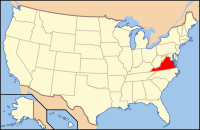Dinwiddie County, Virginia
| Dinwiddie County, Virginia | ||
|---|---|---|

|
||
|
||
 Location in the U.S. state of Virginia |
||
 Virginia's location in the U.S. |
||
| Founded | 1752 | |
| Named for | Robert Dinwiddie | |
| Seat | Dinwiddie | |
| Largest town | McKenney | |
| Area | ||
| • Total | 507 sq mi (1,313 km2) | |
| • Land | 504 sq mi (1,305 km2) | |
| • Water | 3.5 sq mi (9 km2), 0.7% | |
| Population (est.) | ||
| • (2015) | 28,001 | |
| • Density | 55/sq mi (21/km²) | |
| Congressional district | 4th | |
| Time zone | Eastern: UTC-5/-4 | |
| Website | www |
|
Dinwiddie County is a county located in the Commonwealth of Virginia. As of the 2010 census, the population was 28,001. Its county seat is Dinwiddie.
Dinwiddie County is part of the Richmond, VA Metropolitan Statistical Area.
The first inhabitants of the area were Paleo-Indians, prior to 8000 BC. They are believed to have been nomadic hunter-gatherers following animal migrations. Early stone tools have been discovered in various fields within the county. At the time of European contact, Native Americans had territory in the region.
Dinwiddie County was formed May 1, 1752, from Prince George County. The county is named for Robert Dinwiddie, Lieutenant Governor of Virginia, 1751–58. The county raised several militia units that would fight in the American Revolution.
Dinwiddie County was the birthplace of Elizabeth (Burwell) Hobbs Keckly, a free black dressmaker who worked for two presidents' wives: Mrs. Jefferson Davis and later Mary Todd Lincoln. Thomas Day was also a native; he was well known later at Milton, North Carolina, as a free black cabinetmaker. Another native son was Dr. Thomas Stewart, perhaps America's first free black 18th-century rural physician.
During the Civil War the Battle of Lewis's Farm was fought along Quaker Road [Rt. 660]. It took place on March 29, 1865. This was the first in several attempts by Union General Ulysses S. Grant to cut Robert E. Lee's final supply line—the Southside Railroad—in the spring of 1865. Here the Union forces led by Brig. Gen. Joshua L. Chamberlain engaged Confederates under Maj. Gen. Bushrod R. Johnson. After sharp fighting, the Union troops entrenched nearby along the Boydton Plank Road, and Johnson withdrew to his lines at White Oak Road. The Union army cut the rail line four days later, after capturing Five Forks on April 1, 1865, at the Battle of Five Forks. Several other engagements were fought in Dinwiddie County, including the Battle of Dinwiddie Court House, Battle of Sutherland's Station, and Battle of White Oak Road.
...
Wikipedia

